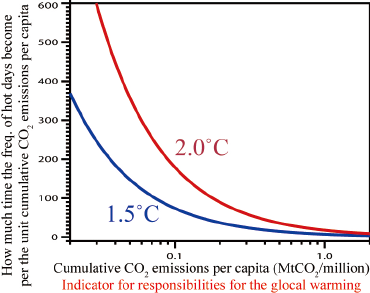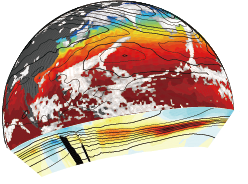In 2015, the historic Paris Agreement concerning retaining the global temperature increase at below 2°C and hopefully below 1.5°C was concluded at COP21, which will accelerate national actions being taken toward further adaptation to and mitigation of global warming. The basis for the aforementioned actions is the huge amount of output from climate change simulations regarding the future path of greenhouse gases, with data having so far been provided by the Coupled Model Intercomparison Project (CMIP) in which world’s climate modeling centers have cooperated in using Global Climate Models (GCMs).
Theme A of the TOUGOU program concerns active involvement in the latest phase 6 of CMIP (CMIP6) using the Earth Simulator and a GCM called MIROC6 that was developed in a previous MEXT program. In addition to historical scenario simulations of 20th and 21st century climate changes a large amount of data will be produced through a number of different types of GCM simulations, and which can then be used to identify scientific priority issues that include near-term climate change predictions, regional sea-level changes, changes in climate extremes, and uncertainty with the Earth’s climate sensitivity. These studies will be used in the aim of contributing to the IPCC 6th Assessment Report (AR6) that will be published in 2021.
Societal concerns about the increasing extreme weather events have been increasing. During previous years ‘Event Attribution’ studies have been carried out with the aim of providing answers to scientific questions relevant to societal concerns, and including the risk of extreme temperature events due to human-induced climate changes over the recent decade as well as near future. This research activity will be expanded upon via Theme A in thereby enhancing society-relevant global warming studies.
Two fundamental technological infrastructures are crucial in achieving the relevant results: a fast supercomputer (namely, Earth Simulator) and GCMs that better reproduce the real climate system. Further development of GCMs with more focus on improving physical processes such as clouds is mandatory, as well as upgrading the data assimilation system for use in near-term climate predictions.
| Subject | Representative | |
|---|---|---|
| (ⅰ)Improving climate models that can contribute to more reliable global environmental predictions | ||
| a | Near-future climate change predictions and promotion of CMIP6 experiments | Hiroaki Tatebe Japan Agency for Marine-Earth Science and Technology, Unit Leader |
| b | Development of climate models with sophisticated physical processes | Kentaro Suzuki Atmosphere and Ocean Research Institute, The University of Tokyo, Associate Professor |
| c | Greater sophistication of land surface models | Yukiko Hirabayashi Institute of Industrial Science, The University of Tokyo, Associate Professor |
| (ⅱ)Reducing the uncertainty of climate change predictions and increasing the depth of scientific knowledge | ||
| a | Understanding and reducing uncertainty of climate sensitivity | Tomoo Ogura National Institute for Environmental Studies, Senior Researcher |
| b | Analysis of factors in past climate changes and unusual weather and future predictions | Masahiro Watanabe Atmosphere and Ocean Research Institute, The University of Tokyo, Professor |
| c | Understanding of cloud-precipitation-circulation process using global nonhydrostatics model | Akira Noda Japan Agency for Marine-Earth Science and Technology, Unit Leader |


